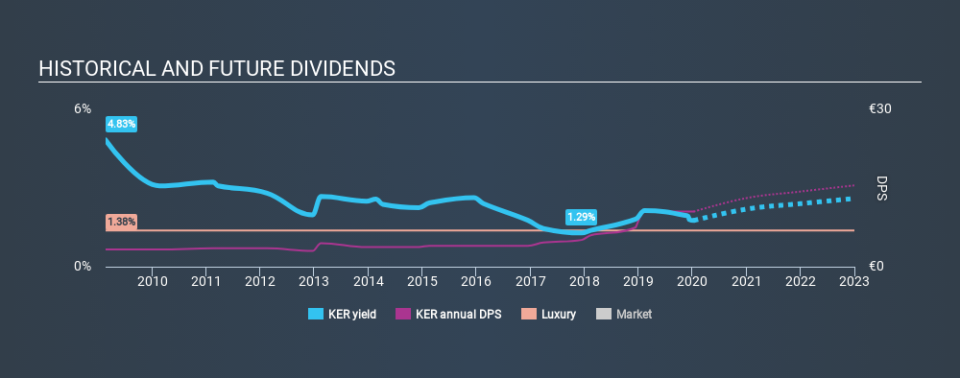Here's What We Like About Kering SA (EPA:KER)'s Upcoming Dividend

Kering SA (EPA:KER) is about to trade ex-dividend in the next 3 days. If you purchase the stock on or after the 14th of January, you won't be eligible to receive this dividend, when it is paid on the 16th of January.
Kering's next dividend payment will be €3.50 per share. Last year, in total, the company distributed €10.50 to shareholders. Based on the last year's worth of payments, Kering has a trailing yield of 1.8% on the current stock price of €595.9. Dividends are a major contributor to investment returns for long term holders, but only if the dividend continues to be paid. So we need to investigate whether Kering can afford its dividend, and if the dividend could grow.
Check out our latest analysis for Kering
Dividends are typically paid from company earnings. If a company pays more in dividends than it earned in profit, then the dividend could be unsustainable. Kering paid out more than half (65%) of its earnings last year, which is a regular payout ratio for most companies. Yet cash flow is typically more important than profit for assessing dividend sustainability, so we should always check if the company generated enough cash to afford its dividend. Thankfully its dividend payments took up just 43% of the free cash flow it generated, which is a comfortable payout ratio.
It's positive to see that Kering's dividend is covered by both profits and cash flow, since this is generally a sign that the dividend is sustainable, and a lower payout ratio usually suggests a greater margin of safety before the dividend gets cut.
Click here to see the company's payout ratio, plus analyst estimates of its future dividends.
Have Earnings And Dividends Been Growing?
Stocks in companies that generate sustainable earnings growth often make the best dividend prospects, as it is easier to lift the dividend when earnings are rising. If business enters a downturn and the dividend is cut, the company could see its value fall precipitously. Fortunately for readers, Kering's earnings per share have been growing at 19% a year for the past five years. Kering has an average payout ratio which suggests a balance between growing earnings and rewarding shareholders. Given the quick rate of earnings per share growth and current level of payout, there may be a chance of further dividend increases in the future.
Many investors will assess a company's dividend performance by evaluating how much the dividend payments have changed over time. Kering has delivered an average of 12% per year annual increase in its dividend, based on the past ten years of dividend payments. It's great to see earnings per share growing rapidly over several years, and dividends per share growing right along with it.
Final Takeaway
Is Kering an attractive dividend stock, or better left on the shelf? We like Kering's growing earnings per share and the fact that - while its payout ratio is around average - it paid out a lower percentage of its cash flow. Kering looks solid on this analysis overall, and we'd definitely consider investigating it more closely.
Wondering what the future holds for Kering? See what the 22 analysts we track are forecasting, with this visualisation of its historical and future estimated earnings and cash flow
We wouldn't recommend just buying the first dividend stock you see, though. Here's a list of interesting dividend stocks with a greater than 2% yield and an upcoming dividend.
If you spot an error that warrants correction, please contact the editor at editorial-team@simplywallst.com. This article by Simply Wall St is general in nature. It does not constitute a recommendation to buy or sell any stock, and does not take account of your objectives, or your financial situation. Simply Wall St has no position in the stocks mentioned.
We aim to bring you long-term focused research analysis driven by fundamental data. Note that our analysis may not factor in the latest price-sensitive company announcements or qualitative material. Thank you for reading.

